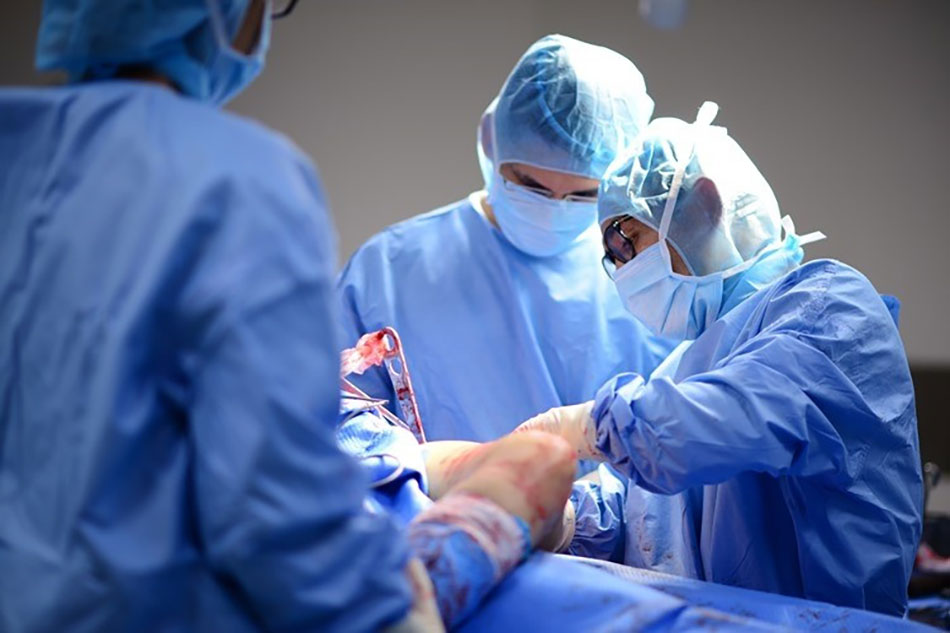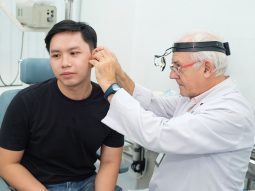The technique of joint replacement surgery without a drainage tube at FV Hospital helps patients to suffer less pain following surgery. They can stand within a day to practice physical therapy and recover faster. In Vietnam, FV Hospital’s Orthopaedics and Hand Surgery Department has applied this technique for many years.
After hip replacement surgery, the patient gets up off the ground for the day
Mr H.V.D (38 years old, from Nha Trang) said: “A year ago, I had pain in my leg. I went to more than 20 doctors, who examined me and offered me medicine, but my condition did not improve. The pain was getting worse and worse. I couldn’t walk normally anymore, so I had to quit my job.”
Recently, thanks to an acquaintance who had undergone a successful hip replacement at FV Hospital, Mr D. decided to visit Ho Chi Minh City to come to FV for treatment.

X-ray image of Mr D.’s leg showing femoral head necrosis
Dr Le Trong Phat, Head of Orthopaedics and Hand Surgery at FV Hospital, diagnosed Mr D. with necrosis of the femoral head in both legs. This condition happens when the cartilage covering the femoral head does not receive enough nutrition, and degenerates and atrophies over time. When the joint does not move smoothly, the patient will have pain when moving. In addition, Mr D. also suffered from gout and psoriasis; due to long-term use of medicine, his liver and kidneys were also affected.
Dr Le Trong Phat—who has more than 30 years of experience in orthopaedic surgery at prestigious hospitals in Germany—replaced the joint on Mr D.’s right side, which was the most seriously deteriorated. The surgery went smoothly and ended within an hour on the morning of September 9, 2022. In the afternoon of that day, the patient was assigned to practice physical therapy to restore function.

Dr Le Trong Phat has performed many successful joint replacement surgeries without needing to insert a drainage tube. (Photo: FV)
Mr D. said that after surgery, the pain had gone and recovered more and more every day. He considers himself lucky as he trusted FV Hospital for his treatment. At noon on September 14, he was discharged from the hospital to the joy of his family and doctors.
Dr Phat said: “Because there is no drainage tube, the patient can get off the ground on the same day to do physical therapy to helps restore his mobility quickly. This is a technique that only FV Hospital applies among healthcare centres operating in Vietnam.”
Applying a modern technique yields better treatment outcomes
Fifteen to 20 years ago, doctors around the world posed the question: What is the difference between a surgery without a drainage tube, and one with a drainage tube? Plastic drainage tubes are inserted from the outside into the surgical site to allow blood and excess fluid to drain after joint replacement surgery. In addition to increasing the potential risk of infection, it also causes friction in the joints, which can cause blood vessels to burst, bleed, and cause pain and discomfort. Thus, the patient must be in bed for one to two days after surgery. However, this is also an important time for the patient to regain their movement function.

Dr Phat applies advanced techniques in joint surgery (Photo: FV)
According to Dr Phat, most doctors are concerned about haematoma, so they choose the traditional method of placing a drainage tube. However, during a surgery, if the bleeding rate is normal, the risk of further bleeding is quite low, and the amount of blood and fluid that leaks after surgery will easily be absorbed by the body.
“Medical studies worldwide and actual practice of treatment for hundreds of joint replacement cases in the past seven years at FV has demonstrated that not having a drainage tube after surgery does not cause harm. Instead, it has many advantages such as pain reduction, reduced risk of infection, and the patient can stand within a day to regain their mobility early. Typically, patients can be discharged from the hospital within three to six days following surgery,” says Dr Phat.

Joint surgery without a drainage tube is an improvement that brings many benefits to patients (Image: FV)
At FV, doctors always apply minimally invasive surgical techniques, focusing on preserving muscle function (without muscle removal) to allow patients to recover quickly. Patient are able to regain their normal range of motion and most joint replacement patients can still practice sports such as cycling, swimming and running.
Dr Phat emphasised: “No drainage is considered a technical improvement in joint replacement surgery. FV always pays attention to improve every detail to make surgery techniques better, which is very important for the patient’s recovery.”
In addition to applying advanced treatment techniques, FV hospital also focuses on infection prevention. The rate of postoperative infection at FV hospital has been below 0.2 per cent for many years. This rate is even lower than hospitals in European countries and the U.S. As FV ensures the success of the surgery, we help patients recover quickly, reduce complications and reduce hospital costs.
In November 2021, FV Hospital began cooperating with Ho Chi Minh City Social Security to pay the cost via National Health Insurance for shoulder, knee and hip replacement surgeries at FV. The payment level covered can be up to 45 per cent of the cost in accordance with the provisions of social insurance, which includes the costs of surgery and transplant supplies, medical equipment and consumables.
For advice on insurance information and services at FV Orthopaedic and Hand Surgery Department, contact: (028) 54 11 33 33.

 Vi
Vi 












